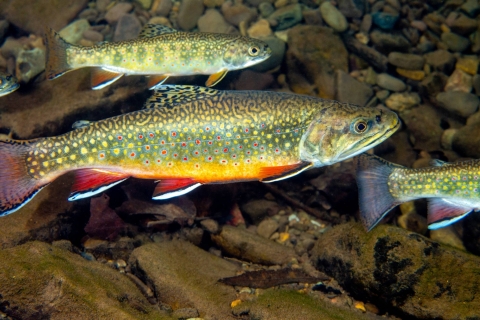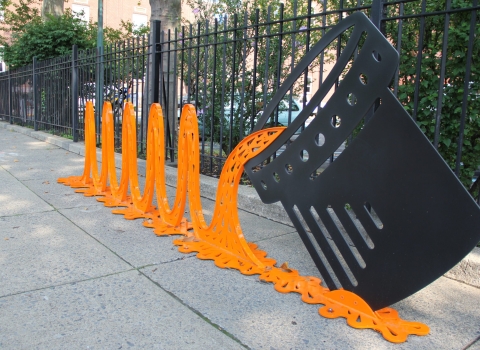To embrace growth and change, is to believe that better days are ahead.
As humans, we often think of a new year as an opportunity for a new beginning. Many of us vow to start an exercise routine, try a healthier diet, or add in some meditation and mindfulness to our days. Some of us might go for a new look, maybe by chopping off some locks or treating ourselves to that rad jacket we saw. Whatever we choose, we attempt to make changes to better ourselves and the way we interact with the world around us. Growing and moving forward, we try and let go of our “old” selves.
If you were say, an American eel, you've grown from an egg to larva, to a tiny clear eel, then yellow and a little bigger, then brownish gray with larger fins. So many metamorphoses have brought you to this moment and you’re ready for one last transformation: parenthood. It’s time to leave your freshwater home and head back to where you were born—the salty seas. It’s a big move, you’ve got a long trip to the Sargasso Sea, but something in you knows how to get there—so long as nothing blocks your path.
And, if you happened to be a choke point in the path for aquatic species like eels and fish, like say a backed up, decaying culvert or a dam, your time of renewal is just around the corner…an infrastructure glow-up if you will.
Across the country, people are working to transform and replenish the landscape—creating opportunities to connect with nature and improving safety around tributaries. In some ways, we are attempting to turn back the hand of time. We want to give nature a chance to be itself again. When we remove a dam, or take out other barriers along a waterway, we give nature a chance to revert to its true form, to become vibrant and rejuvenated.
Some efforts are relatively simple (in theory)—resizing and improving a stream crossing like a culvert, adding some rocks to create riffles for better mussel habitat. Other projects require much more heavy lifting—literally—like removing a dam. But with each barrier removed or altered, nature creeps back in, and the results are phenomenal.
Something temporarily or permanently constructed, built, or placed; and constructed of natural or manufactured parts including, but not limited to, a building, shed, cabin, porch, bridge, walkway, stair steps, sign, landing, platform, dock, rack, fence, telecommunication device, antennae, fish cleaning table, satellite dish/mount, or well head.
Learn more about structure was decaying an ineffective. The larger opening allows for fish passage fish passage
Fish passage is the ability of fish or other aquatic species to move freely throughout their life to find food, reproduce, and complete their natural migration cycles. Millions of barriers to fish passage across the country are fragmenting habitat and leading to species declines. The U.S. Fish and Wildlife Service's National Fish Passage Program is working to reconnect watersheds to benefit both wildlife and people.
Learn more about fish passage and the bridge over the stream safe for vehicular traffic.
“As enthusiasm builds around barrier removal, the East coast is experiencing a boom in projects aimed to connect aquatic animals to their homes.” said fisheries biologist Levi Morgan from the Service’s Appalachian Fish & Wildlife Conservation Office. “Our goal is to allow a stream to be a stream again. By utilizing funding from the National Fish Passage Program and Bipartisan Infrastructure Law Bipartisan Infrastructure Law
The Bipartisan Infrastructure Law (BIL) is a once-in-a-generation investment in the nation’s infrastructure and economic competitiveness. We were directly appropriated $455 million over five years in BIL funds for programs related to the President’s America the Beautiful initiative.
Learn more about Bipartisan Infrastructure Law , we are able to start piecing together waterways like we are doing with the Potomac Headwaters Fish Passage project. As a visitor to project sites, you can see the changes for yourself. Some tributaries are functioning as they would before human infrastructure impacts—life is moving up and down unencumbered.”
This work is imperative to living things that spend their entire existence in one watershed and those who must migrate back and forth between river and ocean. It’s not like there an alternate way to go, they can’t hop out of one stream and walk over to another. Imagine heading home to your apartment on the third floor, but someone put a wall up at the second set of stairs. For some, it would be an interesting but doable climb to get over, for others it may be 100% impossible to surmount this new barrier. Your home is right there, you can see it, you know your full fridge and cozy bed are there waiting for you, but you can’t get to them. Now imagine this was the case for 50 years, 100, 300… You would move, right? You could begrudgingly find a new place if you HAD to, but the animals in these streams have nowhere else to go. They will keep heading up that first stairwell, getting thwarted by that wall, over and over again.
With each completed project, each barrier removed or improved, not only do we help species conquer the obstacles that keep them from their homes, but we also fix unsightly infrastructure and, in some cases, connect people to two sides of a stream. However, the main goal is always front and center: restore aquatic connectivity for all.
This concept is based on opening rivers and their tributaries in a watershed to allow for effective movement throughout for aquatic organisms like fish and mussels. Working with partners, landowners, and other agencies, we take out or replace a barrier with something a fish can safely swim through or over.
“We received some exciting news from our Trout Unlimited partners, who have been spear-heading the Potomac restoration project(s)”, said Morgan. “[They] observed Eastern brook trout moving through the newly constructed, aquatic-friendly box culvert on a tributary to Blue Lick Run, just three short months after the project was completed.” Restored access benefits fish and other aquatic organisms in a variety of ways. It promotes connection to places where animals can weather the seasons, it provides access to food, and opens nursery habitats and breeding grounds. With all this access restored, there will be young fish to replenish the population. We may yet beat the cycle of adult fish aging out and the population will bounce back.
While fish or mussels may go un-noticed by most people, after all neither have the perceived charisma of something iconic like a mountain lion, their impact on their ecosystem is just as significant. Both can serve as a river's version of the canary in the coal mine. They can be indicator species for their watershed, and even though they literally don’t have a voice, they tell us a lot about the health of their environment—and we’re listening.
“Aquatic species curate a waterway into a place full of microhabitats for other organisms,” said Morgan. These unheralded species recharge and energize their environment by spreading nutrients through biological function—food consumption and expelling of waste—and physical movement in the water. When a habitat is severed or fragmented by barriers like a broken-down culvert, this process is thwarted, resulting in less capacity to support life instream and on land.
“Not only do fish and other aquatic species simply deserve to exist, but they ensure that other animals survive and thrive,” said Morgan.
As people help the landscape shed its old, crumbling dams, caved-in culverts, and undersized bridges, a brighter, healthier, and safer ecosystem will emerge. Yawning back to life. Fish will swim further and further up their rivers and streams, mussels will wedge themselves in new riffles and whitewater, and people will be able to fish, hike, and paddle in new places.
So, put on something fresh and fabulous, set out into the new year as a new-and-improved you, and check out the rehabbed habitats in your neck of the woods.





